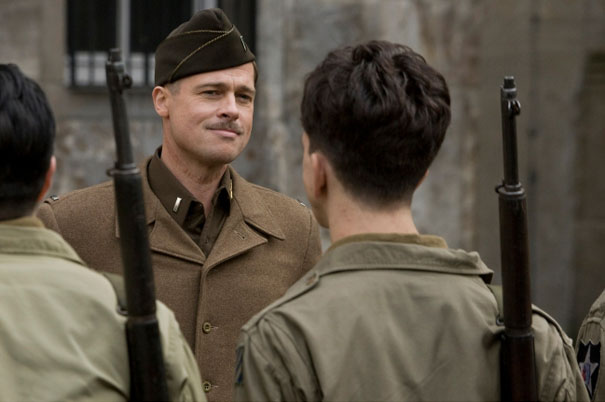In my review of Quentin Tarantino’s Inglourious Basterds, I mentioned that the narrative is constructed like a fugue. As I said, I find this to be a fascinating structure, so I wanted to explore it in depth, both to point out exactly what I meant by it—to clarify the point I was making—and to solidify my interpretation of the screenplay’s assembly.
By their nature, these posts will be rife with spoilers.
There’s a pretty detailed Wikipedia article on fugues, and there’s a better overview on this page, but they’re more technical than I’m going to get. (While there was a point in my life that I had a pretty sophisticated formal music education, it’s been almost a decade now since I’ve studied music academically, and I’m not going to pretend to remember the intricacies or formalities of musical analysis. Besides, that’d make for much more boring posts.) What I am going to do, though, is to speak of the characters in Inglourious Basterds as if they were musical voices, and (hopefully!) show how they enter, exit, intermingle, and eventually come together much in the style of a quadruple fugue. I’m focusing on structure here, and won’t endeavor to belabor my metaphor even further by trying to fit the various appearances of the characters into any more of the formally-defined fugal actions beyond the structural and superficial ones.
The language of musical theory has a lot of variations, so to try to keep things from getting too confusing and complicated, here are the main terms I’m going to use and how I’ll use them:
- A subject is a primary melody, sometimes also called a voice or an element. It’s introduced and then re-visited throughout the piece, often in different keys, typically becoming dissonant at one point before eventually being resolved in its initial key.
- An answer or counterpoint is like a sub-subject. It’s another way of stating the same musical idea, usually in a different key, or shifted on the scale. It’s not as fully-developed as the subject, but its presence helps to enhance the subject.
- A countersubject is a voice that contrasts with the subject, generally by conveying an opposing style or idea. Sometimes a melody (character) will appear as the countersubject in one movement (chapter), but as the primary subject in another.
Because I find the terms counterpoint and countersubject to be confusing (they have almost completely opposite meanings, despite their syntactical similarities), I’ll prefer to use answer or sub-voice to describe a thematic element (character) that reinforces a subject, avoiding counterpoint altogether.
The four voices in Inglourious Basterds, as I see them, are:
 Col. Hans Landa (Christoph Waltz): Introduced at the start of the film in Chapter 1, Landa is the primary and most constant subject throughout the story. His sub-voices are Goebbels, Hitler, and the rest of the Nazis that appear throughout the film. He appears prominently in Chapter 1; he’s re-introduced in Chapter 3; one of his sub-voices is especially present in Chapter 4, the end of which sees him taking its place; he’s present throughout Chapter 5, along with all of his sub-voices, and finds his resolution when he captures Lt. Raine; his voice is found echoing until the very end, in the forest coda.
Col. Hans Landa (Christoph Waltz): Introduced at the start of the film in Chapter 1, Landa is the primary and most constant subject throughout the story. His sub-voices are Goebbels, Hitler, and the rest of the Nazis that appear throughout the film. He appears prominently in Chapter 1; he’s re-introduced in Chapter 3; one of his sub-voices is especially present in Chapter 4, the end of which sees him taking its place; he’s present throughout Chapter 5, along with all of his sub-voices, and finds his resolution when he captures Lt. Raine; his voice is found echoing until the very end, in the forest coda. Shosanna Dreyfus (Mélanie Laurent): Introduced at the end of Chapter 1 as a countersubject to Landa, Shosanna is re-introduced in a different key as Emmanuelle Mimieux in Chapter 3, where her sub-voice is Marcel (Jacky Ido), and her countersubject is Fredrick Zoller (Daniel Brühl). She’s re-introduced again in Chapter 5, where her voice reverts back to its original key after she’s been shot, as her face—as Shosanna again—appears on the screen (and in the smoke).
Shosanna Dreyfus (Mélanie Laurent): Introduced at the end of Chapter 1 as a countersubject to Landa, Shosanna is re-introduced in a different key as Emmanuelle Mimieux in Chapter 3, where her sub-voice is Marcel (Jacky Ido), and her countersubject is Fredrick Zoller (Daniel Brühl). She’s re-introduced again in Chapter 5, where her voice reverts back to its original key after she’s been shot, as her face—as Shosanna again—appears on the screen (and in the smoke). The Basterds: Introduced in Chapter 2, with Lt. Aldo Raine (Brad Pitt) as the primary subject. The sub-voices are the rest of the Basterds, specifically Sgt. Hugo Stiglitz (Til Schweiger), Sgt. Donny Donowitz (Eli Roth), and Pfc. Smithson Utivich (B.J. Novak). There’s also a thematic answer in Raine’s habit of carving swastikas into the foreheads of the Nazis he allows to survive. The Basterds are re-introduced in Chapter 4, where their countersubjects are the Nazis in the tavern and Landa. Their voice is resolved in Chapter 5, with an echo of their sub-voice serving as the film’s coda.
The Basterds: Introduced in Chapter 2, with Lt. Aldo Raine (Brad Pitt) as the primary subject. The sub-voices are the rest of the Basterds, specifically Sgt. Hugo Stiglitz (Til Schweiger), Sgt. Donny Donowitz (Eli Roth), and Pfc. Smithson Utivich (B.J. Novak). There’s also a thematic answer in Raine’s habit of carving swastikas into the foreheads of the Nazis he allows to survive. The Basterds are re-introduced in Chapter 4, where their countersubjects are the Nazis in the tavern and Landa. Their voice is resolved in Chapter 5, with an echo of their sub-voice serving as the film’s coda. Operation Kino: This subject is introduced in Chapter 4 via Lt. Archie Hicox (Michael Fassbender), when he’s briefed by General Ed Fenech (Mike Myers), and is then re-introduced as Bridget von Hammersmark (Diane Kruger) in the tavern scene, where the Nazis (and later Landa) are the countersubject. The Kino voice becomes intertwined with those of the Basterds and Shosanna in Chapter 5, and all three reach their resolution simultaneously during the film’s climactic scene.
Operation Kino: This subject is introduced in Chapter 4 via Lt. Archie Hicox (Michael Fassbender), when he’s briefed by General Ed Fenech (Mike Myers), and is then re-introduced as Bridget von Hammersmark (Diane Kruger) in the tavern scene, where the Nazis (and later Landa) are the countersubject. The Kino voice becomes intertwined with those of the Basterds and Shosanna in Chapter 5, and all three reach their resolution simultaneously during the film’s climactic scene.
I’m using colors to try to help distinguish the various voices and sub-voices, so I apologize to anybody who might be color-blind. I’m sure there’s a more accessible way of doing this that I’m not aware of.
So hopefully now the stage is set. I’m splitting this up into multiple parts, like Todd Alcott does, in the hopes of aiding in readability. In the next post we’ll take a look at the first two chapters of Inglourious Basterds, with all of this in mind.


